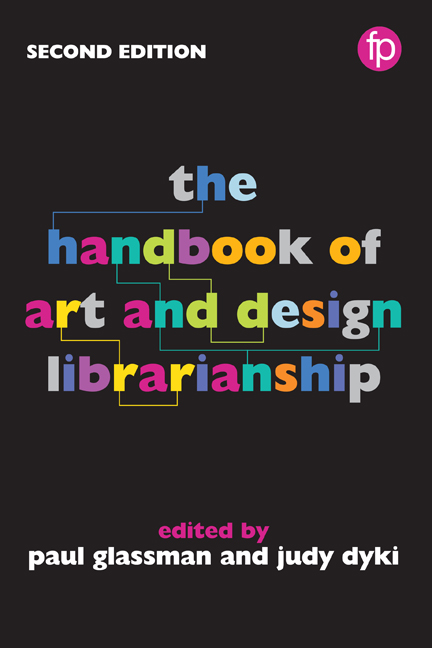Book contents
- Frontmatter
- Contents
- List of figures and tables
- Notes on contributors
- Foreword
- Preface
- Part I Roles and responsibilities
- Part II Materials and collection management
- Part III Teaching and learning
- 14 Embedded in their world: moving mentally into the studio environment
- 15 Teaching with threshold concepts and the ACRL Framework in the art and design context
- 16 Teaching by the book: art history pedagogy and special collections
- 17 Metaliteracy in art and design education: implications for library instruction
- 18 The art of evidence: a method for instructing students in art history research
- 19 ‘I want students to research the idea of red’: using instructional design for teaching information literacy in the fine arts
- 20 Cultural differences and information literacy competencies
- Part IV Knowledge creation
- Part V The physical environment
- Part VI Promotion and sustainability
- Appendix Library profiles
- Index
18 - The art of evidence: a method for instructing students in art history research
from Part III - Teaching and learning
Published online by Cambridge University Press: 08 June 2018
- Frontmatter
- Contents
- List of figures and tables
- Notes on contributors
- Foreword
- Preface
- Part I Roles and responsibilities
- Part II Materials and collection management
- Part III Teaching and learning
- 14 Embedded in their world: moving mentally into the studio environment
- 15 Teaching with threshold concepts and the ACRL Framework in the art and design context
- 16 Teaching by the book: art history pedagogy and special collections
- 17 Metaliteracy in art and design education: implications for library instruction
- 18 The art of evidence: a method for instructing students in art history research
- 19 ‘I want students to research the idea of red’: using instructional design for teaching information literacy in the fine arts
- 20 Cultural differences and information literacy competencies
- Part IV Knowledge creation
- Part V The physical environment
- Part VI Promotion and sustainability
- Appendix Library profiles
- Index
Summary
Introduction and rationale
Within various disciplines, contextual sources such as history, theory and criticism are used to support knowledge claims. However, the discipline of art history assigns the undergraduate a particular challenge with regard to secondary source use. There is specific information that must be closely read and decoded before it can be researched and interpreted – the work itself. ‘Reading’ an artwork requires an entirely different type of literacy, one that is non-textual. Images use a unique syntax (Dondis, 1973; Yenawine, 2014). Art has its own grammar and demands visual literacy – the ability to observe, negotiate and interpret images (Yenawine, 2014). Visual literacy must be learned (Avgerinou and Ericson, 1997; Sinatra, 1986), and learning to see is itself an art (Berger, 1977; Taylor, 1981). Visual literacy is also important for learning: it develops metacognition (Perkins, 1994; Sinatra, 1986) – the awareness of one's own thinking, a precondition for achieving expertise (Zimmerman, 1990).
We live in a visual world. While visual literacy has come to be associated with an almost overwhelming set of skills and abilities (ACRL, 2011; Avgerinou and Pettersson, 2011; Bamford, 2003; Hattwig et al., 2013), there are several statements we can make with regard to teaching and learning them. Visual analysis is an active social process (Bruner, 1989), iterative (Housen, 2001) and takes time (Acton, 1997). This chapter argues that visual literacy may begin simply with the act of observation. Problems arise, however, when untutored viewing meets an almost oppressive body of art historical scholarship. On the one hand, the student should come to a work with a fresh eye (observation); on the other, the student must acknowledge precedent in secondary sources (research). If curiosity is lacking, the student will be overwhelmed by and disengaged from information when it is time to do the research. Lack of curiosity may be a function of assignment design. Any assignment that minimizes the discovery process yet demands second source treatment risks failure. It is tempting for students to plagiarize meaning when research outcomes are sketchy. A student may glance at the art object, skim an art book that tells who the artist is or was, what the artist intended based on his or her political views, or what colours mean, all without making essential connections.
- Type
- Chapter
- Information
- The Handbook of Art and Design Librarianship , pp. 179 - 192Publisher: FacetPrint publication year: 2017



